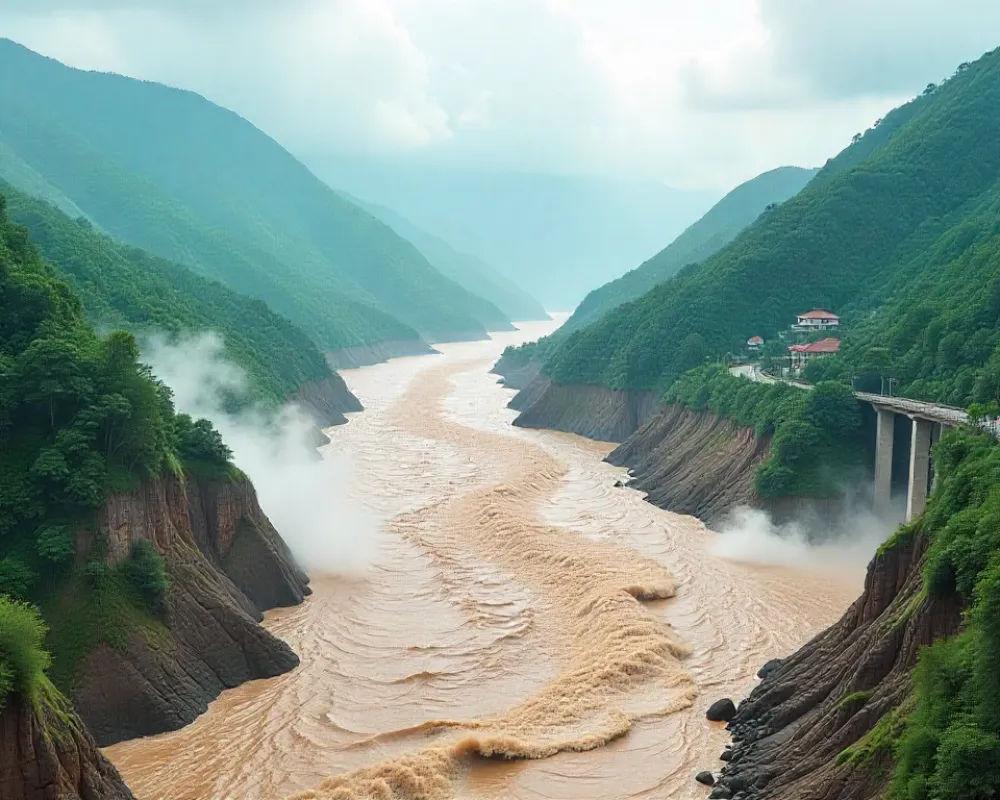Key Facts
- Super Typhoon Ragasa, the strongest storm of 2025, struck Taiwan on September 22–23, killing at least 14 people and leaving 124 missing after a barrier lake burst in Hualien County.
- The lake, formed by landslides, unleashed 91 million tonnes of water (≈36,000 Olympic pools), creating a “tsunami-like” flood that tore through Guangfu township.
- The Central Weather Administration recorded winds up to 263 kph, rainfall exceeding 600mm in 24 hours, making Ragasa as intense as a Category 5 hurricane.
- A major bridge collapsed, power outages hit 8,000+ households, and 5,200 people were forced to shelter on higher floors of homes.
- The storm also hit the Philippines, Hong Kong, and southern China, causing mass evacuations, 600+ flight cancellations, and widespread flooding.
Background & Storm Development
Ragasa became the year’s first super typhoon on September 21 before striking the Philippines, where it killed three and displaced thousands. By September 23, it battered Taiwan’s eastern mountains, triggering landslides and a natural dam collapse that caused catastrophic flooding.
Voices from the Ground
- Local postman Hsieh Chien-tung: “The water hit like a tsunami. My car was swept into the living room.”
- Wang Tse-an, Dama village chief: “It’s chaotic now. There are mud and rocks everywhere.”
Government Response
- Premier Cho Jung-tai has ordered an inquiry into evacuation failures, noting: “This is not about blame, but uncovering the truth.”
- President Lai Ching-te, who earlier highlighted Taiwan’s disaster readiness during Typhoon Danas (Aug 2025), pledged relief subsidies and agricultural aid.
- 340 military troops and emergency crews are conducting rescue operations; food and water are being distributed in Guangfu.
Regional & International Impact
- Hong Kong raised Signal 10, its highest typhoon alert, with 230 kph winds and lamppost-high waves. Nearly 700 residents sought shelter.
- China evacuated 1.9 million people across Guangdong, with 400,000 in Shenzhen alone. Flights and ports were suspended.
- Over 600 flights were cancelled in Hong Kong, with hundreds more across East Asia.
Economic & Climate Context
- The disaster struck a tourist hotspot, disrupting both agriculture and semiconductor-linked supply chains.
- Experts warn storms are becoming more intense with climate change. NTU professor Kuo Hung-Chi stressed: “The intensity of storms has been rising over the past decade.”
Frequently Asked Questions (FAQ)
1. What is Super Typhoon Ragasa?
Super Typhoon Ragasa is the strongest storm of 2025, classified as a Category 5-equivalent tropical cyclone, with winds exceeding 260 kph.
2. When did Typhoon Ragasa hit Taiwan?
Ragasa struck Taiwan on September 22–23, 2025, after intensifying over the Pacific Ocean.
3. How many people died in Taiwan due to Ragasa?
As of September 24, at least 14 people are confirmed dead, with 124 still missing in Hualien County.
4. What caused the barrier lake disaster in Hualien?
Continuous rainfall and landslides formed a natural dam in the mountains. On September 23, the dam collapsed, releasing 91 million tonnes of water that flooded Guangfu township.
5. How bad was the flooding in Guangfu township?
The flood created a “tsunami-like” wave, destroying homes, sweeping away cars, collapsing bridges, and forcing over 5,200 people to seek shelter on higher floors.
6. Which other regions were affected by Ragasa?
- Philippines – at least 3 killed, thousands displaced.
- Hong Kong – highest storm warning (Signal 10), 600+ flights cancelled.
- Southern China (Guangdong, Shenzhen) – 1.9 million evacuated.
7. How is the Taiwan government responding?
- Premier Cho Jung-tai ordered an investigation into evacuation failures.
- President Lai Ching-te pledged relief subsidies, infrastructure repair, and agricultural aid.
- Military and rescue units are distributing food, water, and supplies.
8. Is climate change making typhoons worse?
Scientists warn that warming oceans intensify tropical storms, leading to stronger winds, heavier rainfall, and greater flood risks, though direct attribution to Ragasa requires further study.
9. Why is this disaster globally significant?
Taiwan is a global hub for semiconductors and tech supply chains. Extreme weather events like Ragasa highlight the economic and geopolitical risks tied to climate change and regional vulnerability.
 Sseema Giill
Sseema Giill







 Trending Now! in last 24hrs
Trending Now! in last 24hrs



